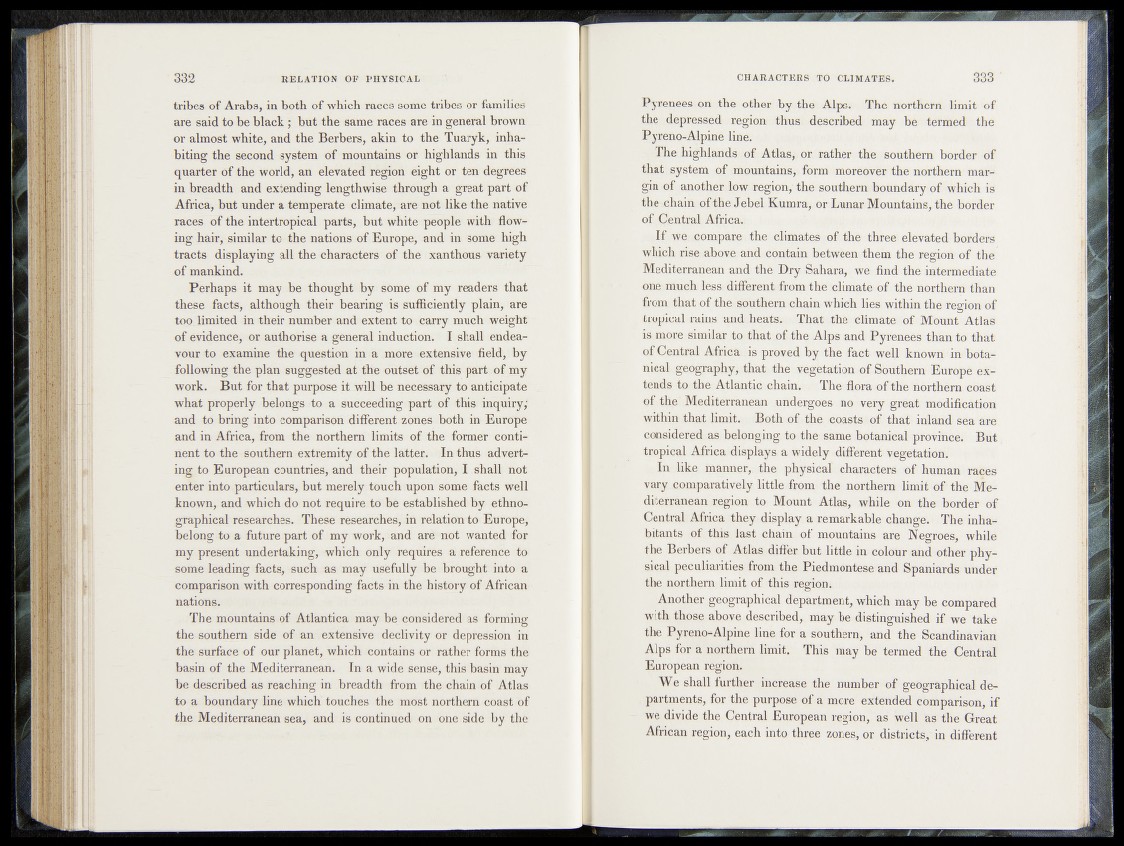
tribes of Arabs, in both of which races some tribes or families
are said to be black; but the same races are in general brown
or almost white, and the Berbers, akin to the Tuaryk, inhabiting
the second system of mountains or highlands in this
quarter of the world, an elevated region eight or ten degrees
in breadth and extending lengthwise through a great part of
Africa, but under a temperate climate, are not like the native
races of the intertropical parts, but white people with flowing
hair, similar to the nations of Europe, and in some high
tracts displaying all the characters of the xanthous variety
of mankind.
Perhaps it may be thought by some of my readers that
these facts, although their bearing is sufficiently plain, are
too limited in their number and extent to carry much weight
of evidence, or authorise a general induction. I shall endeavour
to examine the question in a .more extensive field, by
following the plan suggested at the outset of this part ,of my
work. But for that purpose it will be necessary to anticipate
what properly belongs to a succeeding part of thi^lnqfiiry/
and to bring into comparison different zones both in Europe
and in Africa, from the northern limits of the former continent
to the southern extremity of the latter. In thus adverting
to European countries, and their population, I shall not
enter into .particulars, but merely touch upon some facts well
known, and which do not require to be established by ethnographical
researches. These researches, in relation to Europe,
belong to a future part of my work, and are not wanted for
my present undertaking, which only requires a reference to
some leading facts, such as may usefully be brought into a
comparison with corresponding facts in the history of African
nations.
The mountains of Atlantica may be considered as forming
the-southern side of an extensive declivity or depression in
the surface of our planet, which contains or rather forms the
basin of the Mediterranean. In a wide sense, this basin may
be described as reaching in breadth from the chain of Atlas
to a boundary line which touches the most northern coast of
the Mediterranean sea, and is continued on one side by the
Pyrenees on the other by the Alps.- The northern limit of
the depressed: region thus, described may be termed the
Pyreno-Alpinè 11$$-.;,**!
The highlands of Atlas*, or rather the southern border of
that system of mountains, form moreover the northern margin
of another iowvregipn; the.southem boundary of which is
thexhain of the J ebel Kumra, rorrLunar Mountains, thé border
of Central Africa.?
If wer,compare. thlé .climate^iof .thei||pt# elevated bordem
v|hich rise above andxomtain between,them the region of th&.
Mediterranean and the Dry Sahara, we, find the intermediate
one much; less, different from the climate ©ftthe northern*;than
frdpi that of the southern chain which lies, within the Tegion of
tropical rains and heats. That the climate' offfdount Atlas
is. more similar to that nf the Alps and Pyrenees than to that
of Central Africa, is proved by the fact weMfeknown in botai^
nicaL;ge©graphy* that the vegetation of Southern- Europé extends
to the Atlantic chain. The-flora ofthe northern coast-
of the* Mediterranean undergoes no very great modification
within that limit. Both of the coasts^of that inland sea are
considered as belonging tosthe same botanical province. But (
tropical Africa, displays a widely different vegetation.
In like manner,, .the physical- characters of human races
vary comparatively little from the northern limit of the-Me^
diterranean region to Mount Atlas, while on the border of
Central Africa they display a remarkable change. The inhabitants
of this last chain of mountains are Negroes, while
the Berbers of Atlas differ but little in colour and other physical
peculiarities from the Piedmontese and Spaniards under
the northern limit of this region.
Another geographical department, which may be compared
with those above described* may be distinguished if we take
the Pyreno-Alpine line for a southern, and the Scandinavian
Alps for a northern limit. This may be termed the Central
European region*
We shall further increase the number of geographical departments,
for the purpose of a more extended comparison, if
we divide the Central European region, as well as the Great
African region, each into three zones, or districts,rin different
man